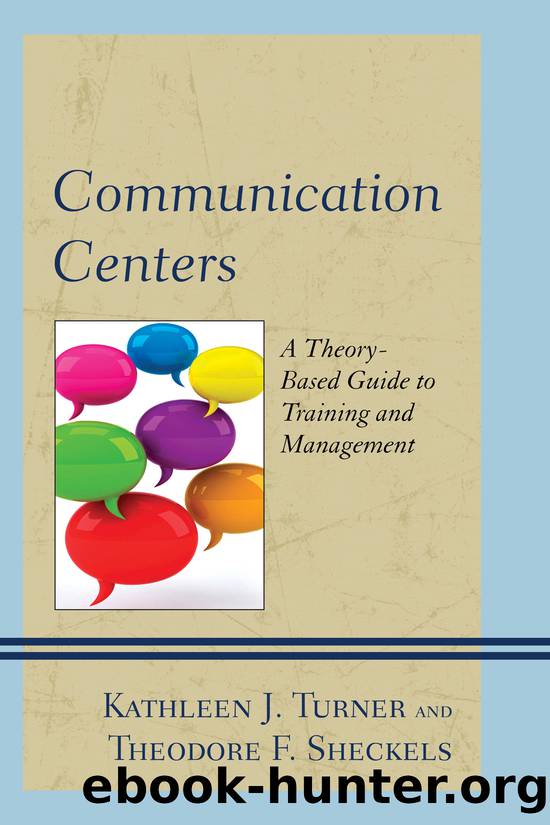Communication Centers by unknow

Author:unknow
Language: eng
Format: epub
Publisher: Lexington Books
Chapter 8
Tutoring Tasks
Presentation Aids
In the preceding chapter, we jumped the gun a bit in talking about presentation software. The goal in that chapter was to talk about how to help students learn to deliver a speech well while using the software. In this chapter, the goal is different. It is to discuss why and how to use visualsânot just presentation software but a wide range of presentation aids.
Uses of Visuals
One reason to use visual images is, perhaps unfortunately, because they are expected. First, we have become such a visual culture that a presentation without images seems naked or incomplete. Second, perhaps without thinking about it, we make judgments about the quality of a presentationâand a presenterâbased on the quality of his or her visuals. This second point relates to the concept of ethos: we assume that the maker of high-quality visuals is of high quality (i.e., is competent) in other areas. Neither of these reasons for using visuals is unimportant, but there are other, more rhetorical reasons for doing so.
Illustration. The first is to illustrate an idea. Often it is an idea that will be much clearer if shown visually. It could be a businessâs organizational chart, or it could be a complex biochemical process. It might be raw data, illustrated in a table that the audience will be guided in studying, or it might be a graph of one sort or another showing how a whole is divided, how a variable has changed over time, or how two (or more) variables compare. Perhaps just as often a visual will be employed if its use makes an idea more vivid for the audience. Here is where pictures often come in. Once, they were difficult to come by, but, in the age of Google Images, they are readily available.
Students (and perhaps others) have a tendency to overload a presentation with visuals. Communication center tutors should help students resist this tendency, for it is very easy for visuals to take over a presentation, making the orally delivered text little more than the accompaniment. Students should choose visuals carefully, whether the purpose is to add clarity or to add vividness.
Guidance. Another function is to guide the audience through the presentation. Before presentation software, this function was occasionally served by a poster or a flip chart page that offered an outline of where the presentation was going to go. Perhaps the poster was visible throughout as a reminder; perhaps the flip chart page was repeated as a reminder. With presentation software, an audience can be guided not just through the overall structure but through the structure of every component. This represents a valuable use of visual technology; however, as we will discuss later, it can be overdone.
Readability, Clarity, Control. In earlier decades, visual images were rare in academic writing. They began to appear more frequently in technical and business fields, so the earliest discussions of how to use them well appeared in technical and business communication courses. Although much has changed over the decades, three fundamental principles introduced in those textbooks still seem valid.
Download
This site does not store any files on its server. We only index and link to content provided by other sites. Please contact the content providers to delete copyright contents if any and email us, we'll remove relevant links or contents immediately.
A Friend in the Dark by Pascal Ruter(179)
Different-Worlds-18 by Unknown(167)
The Art of SEO by Eric Enge Stephan Spencer and Jessie Stricchiola(167)
Digital Infrared Photography Photo Workshop by Sandidge Deborah(165)
Man-Machine-Environment System Engineering by Unknown(164)
The Pyramid Mind by Vlad Beliavsky(156)
Encyclopedia Of Mathematics (2005) by Unknown(144)
Brave by Wendy Constance(141)
The Three Rs and the Humanity Criterion by Michael Balls(131)
å¯åå °å²å¦æéï¼è±æ by 冯友兰(126)
Pirates, Prisoners, and Lepers: Lessons from Life Outside the Law by Paul H. Robinson & Sarah M. Robinson(121)
Command-Line by Unknown(115)
To Me, The One Who Loved You by Yomoji Otono(113)
SAYE by Wu Zhe(112)
Fairy Tales for the Disillusioned by Gretchen Schultz(109)
Different Worlds #12 by Unknown(108)
Randolph Caldecott--The Man Who Could Not Stop Drawing by Leonard S. Marcus(106)
ä¸å½å¤å ¸æå¦ç®å²ï¼è±æ by 冯沅君(105)
Computational Geometry by Unknown(105)
